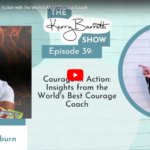
So much of my job involves convincing my audience that video is invaluable to their growth and professional prosperity. Once convinced, I then have some heavy lifting to do with respect to my clients’ fear of being on camera or lack of confidence on screen.
While I’m happy and motivated to manage both of these tasks, what I really feel energized about is teaching people how to create their video marketing strategy, once they’re fully on board with the value of video and their ability to leverage it.
That’s why today’s blog post is all about teaching you how to envision and execute a compelling video marketing strategy that will convert your audience into loyal followers who take action on your offers.
Here, I’ll take you through 10 steps to create your video strategy and then wrap up with a recap of the benefits behind your commitment to video marketing. For those of you who already believe in the power of video, you can consider the benefits section like a checklist that shows whether your video strategy is actually working for you.
Let’s do this!
10 steps leading to your video marketing strategy
If creating a strong video marketing strategy sounds daunting — and I get it! — just remember the adage about eating an elephant. We’re doing this one bite (step) at a time…
- Define your objectives: Clearly outline what you want to achieve with your video strategy. This could include increasing brand awareness, driving sales, educating your audience, or engaging with your community.
- Understand your audience: Know who you are targeting with your videos. Understand their preferences, needs, and the platforms they frequent in order to tailor your content to resonate with them.
- Develop a content plan: Plan the types of videos you will create. This could range from educational content, how-to guides, product demonstrations, customer testimonials, to behind-the-scenes footage. Ensure diversity in your content to maintain audience interest. Ask yourself what your audience needs to know and then create your plan to deliver that information effectively.
- Focus on storytelling: A compelling narrative can make your videos more engaging. Think about how you can tell a story about your brand or products that connects emotionally with your audience. Without that connection, it will be that much harder to convert them into customers or clients.
- Prioritize video quality: Invest in good production quality. This doesn’t necessarily mean spending a lot of money, but rather ensuring clear visuals and audio support your overall professional presentation.
- Optimize for individual platforms: As we know, different social media platforms have different video requirements and audience expectations. That’s why it’s crucial that you take the time to customize your video format, length, and style for each platform you plan to use.
- Incorporate SEO practices: Use relevant keywords in your video titles, descriptions, and tags to make them more discoverable. Closed captions and transcripts can also improve accessibility and SEO.
- Plan your publishing schedule: As with most things that matter, consistency is key in video strategy. Determine a posting schedule that works for you and stick to it. This helps build anticipation and keeps your audience engaged.
- Engage with your audience: Respond to comments and feedback on your videos. Engaging with your audience can build a community around your content and enhance loyalty.
- Analyze and adapt: Regularly review your video performance metrics to understand what works and what doesn’t. Use this data to refine your strategy and content over time.
Ultimately, a successful video strategy is not just about producing great content, but also about how effectively you distribute and market your videos to reach and resonate with your target audience. Consider it like a two-pronged tool, with one prong representing the content creation and the other content execution.
For those of you who are not totally on board with video marketing, I’ve outlined some benefits below. And for those who are convinced — or have already experienced — the power of video to boost your brand and business, use these benefits as a checklist for whether your video marketing strategy is really serving you and your audience.
What are the benefits of creating a compelling video strategy?
Don’t sleep on these benefits behind a compelling video strategy. When created and executed effectively, video marketing can afford you the following…
Increased engagement
Videos are highly engaging and can capture the attention of your audience more effectively than other forms of content. They encourage viewers to spend more time interacting with your brand.
Enhanced brand awareness
Through creative and engaging videos, you can increase your brand’s visibility. Videos are shareable across various platforms, helping to extend your reach to a broader audience.
Improved conversion rates
Videos can effectively convey information and emotion, which can lead to higher conversion rates. For instance, product demonstrations or customer testimonials in video format can significantly influence purchasing decisions.
Better SEO performance
Videos can improve your search engine rankings. Websites with video content are more likely to rank higher on Google. Also, YouTube, being the second largest search engine, can drive additional traffic to your site.
Stronger emotional connection
Videos have the power to evoke emotions, which can create a stronger bond between your brand and your audience. This emotional connection can lead to increased brand loyalty.
Enhanced learning and retention
People generally retain information from videos better than text. Educational or instructional videos can be very effective for training purposes or for explaining complex concepts.
Increased accessibility
Videos can make your content more accessible to a diverse audience, including those who prefer visual or auditory learning or those with certain disabilities.
Content versatility
Video content can be repurposed in multiple ways. For example, a long video can be edited into shorter clips for social media, or its audio can be used for podcasts.
Competitive advantage
A well-executed video strategy can set you apart from competitors, especially if they are not leveraging video effectively.
Data and insights
Video platforms often provide detailed analytics, giving you valuable insights into viewer behavior and preferences, which can inform future content and marketing strategies.
When all is said and done, by harnessing the power of video, you are able to communicate your message more effectively, engage with your audience on a deeper level, and achieve your marketing and communication goals more efficiently. In other words, there’s absolutely no reason not to invest in video!
Listen, I know it’s easier said than done and, frankly, creating a video strategy — especially for the first time — is a tall order. But, that’s why I’m here to help you.
At the end of the day, I am inspired by every opportunity that I have to help my clients use video as the impactful tool I’ve personally experienced it to be.




